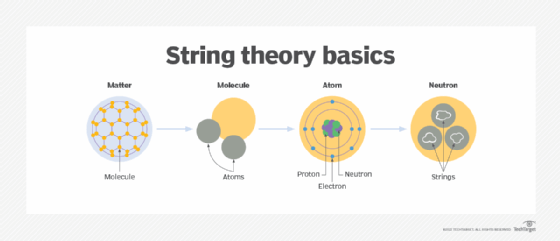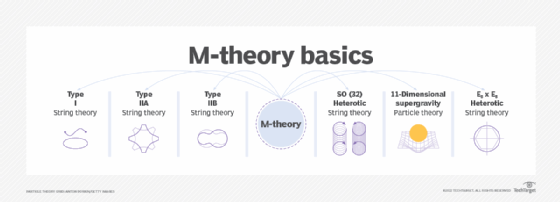11th dimension
What is 11th dimension?
The 11th dimension is a characteristic of space-time that has been proposed as a possible answer to questions that arise in superstring theory. The theory of superstrings involves the existence of nine dimensions of space and one dimension of time for a total of 10 dimensions.
Over the years, multiple variants of string theory have emerged, all attempting to provide a theory of everything that explains how the universe works, with the goal of uniting general relativity and quantum mechanics. Of these variants, five are considered the most viable.
All five variants demonstrate mathematical consistency. However, they look different from each other and exhibit different characteristics, to the point of seeming contradictory in places. More importantly, each one offers only a partial glimpse into how everything works. To address these limitations, M-theory emerged, tying together the five string variants, and introducing the concept of an 11th dimension.
What is superstring theory?
According to superstring theory, all the elementary particles in the universe are vibrating, one-dimensional filaments of energy known as strings. Strings have no width or height but they do have length, which is estimated to be 10-35 meters, many times smaller than the diameter of an atom's nucleus.
Every subatomic particle is a vibrating string, according to string theory. The string's movement determines the type of particle and its characteristics, whether a photon, electron, graviton or other type of particle. In this respect, a string acts much like a violin string whose vibrations determine the note and tone.
Still, string theory is only a mathematical model and lacks concrete experimental evidence to prove its accuracy. Even so, the model provides an elegant description of the fundamental components that make up the universe. It also predicts the existence of 10 dimensions rather than four.

Prior to the introduction of string theory, it was generally believed that we lived in a universe with four dimensions -- three spatial and one temporal.
- First dimension. Linear dimension that has length but no width or height. This dimension is typically represented as a line that connects two points.
- Second dimension. Flat dimension that has length and width to create a defined area, but it has no height, much like a sheet of paper or computer display.
- Third dimension. Dimension in which we experience the world around us, with length, width and height. Three-dimensional objects -- such as cubes or spheres -- contain volume.
- Fourth dimension. Time dimension that extends the three-dimensional world by incorporating events that enable three-dimensional objects to move forward and change. The concept of a fourth dimension plays a key role in the general theory of relativity.
String theory introduces six more dimensions that are "curled up" or "compactified" into very small spaces. The six dimensions can be perceived only by the strings and are otherwise undetectable, but their configurations play a pivotal role in determining the properties of subatomic particles. They also provide the conceptual underpinnings needed by the five primary variants of string theory to make the mathematics work. Yet even with 10 dimensions, the variants still fall short in the quest for a theory of everything.
What is M-theory?
M-theory attempts to address these limitations by adding an 11th dimension, along with the concept of membrane or brane. Like the string, a brane is theorized to be a universal building block that provides the foundation of all matter. However, unlike the original strings, branes add dimensionality, making them more flexible than strings alone. For example, a universe with 11 dimensions can support one-dimensional strings (1-brane), two-dimensional planes (2-branes) and perhaps other dimensional branes.

This added dimensionality requires an 11th dimension to make it mathematically feasible. The new dimension and its accompanying branes also resolve the limitations of the five string variants. Rather than treating them as conflicting theories, the 11th dimension makes it possible to see them as different aspects of a much larger whole, each viewing the universe from its own perspective. Furthermore, M-theory, with its 11 dimensions and collection of branes, offers a viable mathematical theory of everything, unlike its string predecessors. Nevertheless, as with string theory, M-theory still lacks concrete experimental evidence to move it beyond equations.
